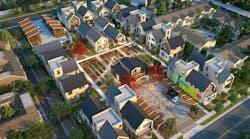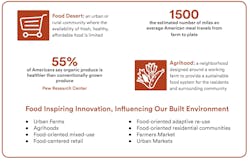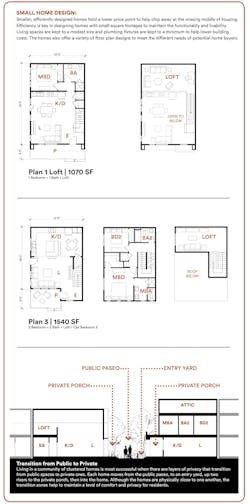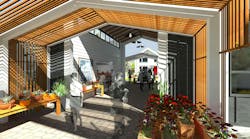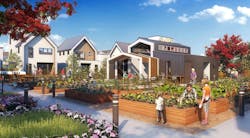Agrihoods, communities that are centered around working farms, have become very popular with homebuyers who want a healthier lifestyle for themselves and their children. Examples of successful large-scale agrihoods in suburban and rural locations can be found all over the United States.
But what if the agrihood could be scaled down to fit urban infill sites? KTGY Architecture & Planning’s R+D Studio has a solution: The Patch, a small working farm on an urban infill site surrounded by modestly sized homes. David Senden, principal in KTGY’s Irvine, Calif., office, explained the conceptual design to DI.
DI: David, what exactly is The Patch?
David Senden: The Patch is an infill version of the agrihood—a solution for residential development that supports sustainable food systems and aims to cultivate community through infill farming. It has enough open space for a small working farm on an infill site; clustered homes with modest footprints that preserve enough land for farming; common open space; and private yards. Landscape design is a key element in creating a pleasant walking experience, promoting interaction among neighbors, and fostering a strong sense of community.
DI: Developers of large-scale agrihoods have found that it’s critical to have an experienced farm manager, with good people skills, on staff. I gather that it’s no different for smaller agrihoods.
Senden: Incorporating a working farm within a residential community can present challenges. There are few farm models to choose from that address the needs and goals of the residents.
So we’ve created two models, both of which require a third party to work and maintain the community farm:
- With Community-Supported Agriculture, or CSA, consumers subscribe to a harvest of a certain farm or group of farms and in return receive a box of produce or other farm goods on a weekly or bi-weekly schedule.
- The Urban Farming Venture is a third-party organization that designs, installs, and maintains urban farms. Scheduled farming service also includes pest and disease control and harvesting.
These models aim to create a relationship between the farmer and the community, and support a sustainable food system that promotes healthy eating and healthy communities.
DI: What about parking?
Senden: We envision a time when we’re not as dependent on personal automobiles. In fact, autonomous vehicles and car sharing may eliminate the need for such high parking ratios. Therefore, we propose a parking-lift concept that would get cars out of the middle of the site.
DI: How do you think the parking-lift idea will be received by local jurisdictions? Isn’t it kind of expensive?
Senden: Many jurisdictions are warming up to mechanical parking solutions. Some see it as a way to reduce asphalt and allow for more green space, while others are not as accepting. Change is hard and naturally, some people resist it.
The mechanical part of a simple parking lift costs about $8,000 per space, so, not so much. The bigger challenge is probably in the management of those spaces, especially if your neighbor’s car is above or below yours.
DI: What’s the benefit of detaching the parking from the homes?
Senden: Vehicular paths are minimized, and the community becomes more walkable and encourages neighbors to interact. The lush, landscaped paths help create a pleasant walking experience with their fruit trees, edible flowers, and berries. Landscape markers will identify the edible plants and reinforce the idea of food education.
DI: How much land is needed to develop one of these communities? Is there a minimum acreage?
Senden: There’s no minimum acreage. At some point, it becomes a garden and not a farm. Remember, the concept is still in its infancy. Modern farming is about efficiency. Concepts like The Patch look to the past where small villages looked to be self-sustaining without relying on outside corporations for support. Obviously, the smaller the plot, the less sustainable this is.
DI: Does The Patch require a full- or part-time farm manager?
Senden: These farms and gardens need someone to love them. More important, they need somebody to do the unglamorous parts—weeding, spreading manure, cleanup. Our society has evolved where it is more likely that people will pay someone to help with the farm. It might be an employee of the development company, or a company that tends several agrihoods, but we would anticipate some professional support.
DI: Are there versions of The Patch being planned or under construction, or is it still just conceptual?
Senden: There are several projects where community gardens are either being planned or have been built, but most of them are simply another amenity. The Patch was conceived as more of a lifestyle, with the garden/farm as its heart. But it’s about more than just the vegetables; parking has intentionally been reduced and pushed to the exterior of the community, eliminating a lot of the pavement. There are no garages. This draws the community closer together, making it safer for children, and harks back to a time when the automobile wasn’t the driver of design.
DI: How do you think The Patch will go over with local planning/zoning officials and neighborhood organizations?
Senden: There are several aspects to this idea that could get some pushback, not the least of which is the handling of the parking. Many suburban locations require covered or garage parking for each unit, which is a challenge. What we’re trying to do is replace all of that land devoted to cars with land devoted to quality of life: space for residents to come together for health and in a spirit of community. Getting your hands dirty in a garden is one way to do that.
DI: What types of sites or neighborhoods would be optimum for The Patch? Would it work for the inner city as well as suburban locations?
Senden: The idea could work in most places. In fact, denser locations probably work better. In neighborhoods where there are transportation options, or closer to work centers, make this idea more viable. The idea is to show that you don’t need to live alone on an acre of land to grow your food.
We think that a fairly dense housing solution, designed around young buyers just putting down roots in a close-in location, makes a lot of sense. There will certainly be compromises in lifestyle, but what you get back more than makes up for [what you give up].
DI: Do you have a vision for the housing designs as far as exterior materials and elevations, or will that be dictated by adjacent residential?
Senden: Because this is a fairly forward-looking idea, we think the architecture should speak to [the neighborhood context], but in a very real way. The homes we have designed take some cues from the agrarian nature of The Patch, but have been infused with a more contemporary take. We would expect that as this is modified for a given location, it would morph based on geography, city preferences, and target market.
DI: Will the homes be market-rate affordable? Subsidized? A combination of the two?
Senden: The Patch could work for either market-rate or subsidized housing. In our minds, it’s not so much about economic status as it is about a lifestyle and the idea that being more local and more connected to your food source and your neighbors is the important thing. We could make this work at many income levels.
DI: Will nonresidents be invited to interact with the farm and community events?
Senden: Ideally, The Patch won’t operate in a vacuum. It will be connected to the larger neighborhood and operate as a communal heart. There certainly are challenges to managing the farming part of this, but our feeling is that people who choose this lifestyle are likely to be more inclusive rather than less. We are moving more and more into a sharing culture. People share cars, bicycles, and vacation houses; why not vegetables?
Having a farm in your own front yard encourages a relationship between the community and farmer, and is supported through hands-on educational programs and harvesting. Knowing your farmer and knowing where and how your food is grown is becoming another aspect of healthy living.
DI: What other features of The Patch encourage socializing among residents?
Senden: There’s a Commons Building that serves as a central hub for neighbors and provides multiple functions for the community. It has an office for the farmer; storage space for farm equipment; and a community kitchen with a large outdoor gathering space for community events. An open breezeway through the Commons Building offers a peek at the farm from the street and acts as a gateway into the project.
DI: I know of several large-scale agrihoods around the United States that are quite successful. Are there lessons to take away for The Patch?
Senden: Each neighborhood is different. A lot of it has to do with the level of commitment of the residents. While farming your own vegetables seems romantic and interesting, many people don’t realize how much actual work is involved. It’s difficult both physically and mentally. In the big agrihoods, it’s likely that a professional farmer will operate and maintain the crops with the help of the residents.
I should point out that while our renderings depict lush foliage at the height of growing season, there are times when a farm isn’t the prettiest thing to look at and there are periods when tilling the soil, mixing in compost, and pulling weeds aren’t the most satisfying experiences. We expect there would be quite a bit of outside help.
About the Author

Susan Bady
Susan Bady has been writing about the housing industry for 30 years. She is senior editor of Professional Builder and Custom Builder magazines, and produces the Design Innovation e-newsletter. Bady has also written for such consumer magazines as Cabin Life and Better Homes and Gardens’ Home Plan Ideas.
